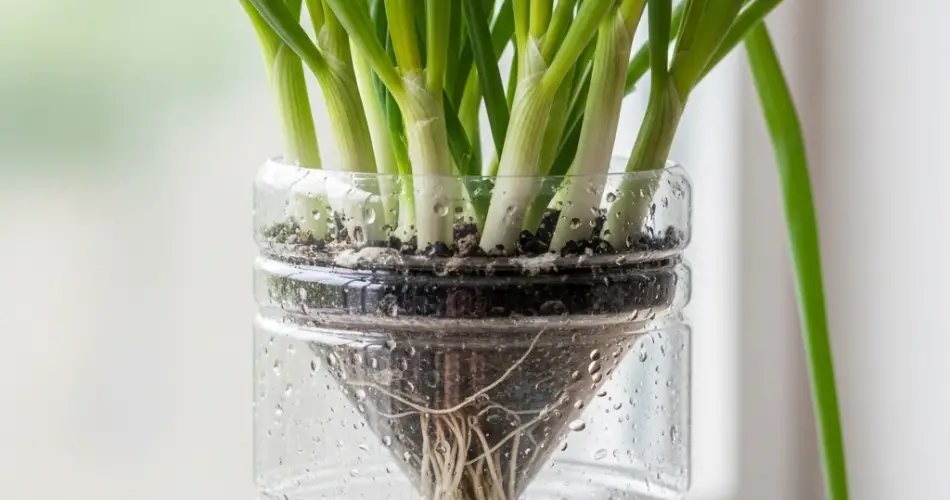Fresh scallions are a kitchen staple, adding a mild onion flavor and crisp texture to countless dishes. Instead of buying bunch after bunch, you can regrow scallions at home using the bottle method—a simple, space-saving, and eco-friendly technique that works in even the smallest of spaces. This method lets you enjoy a constant supply of green onions without the need for a large garden or complex tools.
Why Choose the Bottle Method?
Growing scallions in bottles offers several advantages:
-
Cost savings – Regrow scallions from kitchen scraps instead of purchasing new ones every time.
-
Space efficiency – Ideal for apartments, small kitchens, or balconies.
-
Sustainability – Reuses bottles and reduces plastic waste.
-
Year-round harvest – Works indoors in any season.
The bottle method is suitable for beginners because scallions are hardy, adaptable, and quick to sprout, making the process almost foolproof.
Materials You’ll Need
-
Plastic bottles (1–2 liters) or glass jars
-
Sharp scissors or craft knife (for cutting plastic bottles)
-
Clean water
-
Scallion bulbs with roots intact (from the grocery store or garden)
-
Optional: Potting soil (if you prefer soil growing instead of water)
Preparing the Bottle
For Water Growing:
-
Select a bottle or jar tall enough to hold the scallion bulbs upright.
-
Rinse it thoroughly to remove any residues.
-
Fill with just enough water to cover the roots of the scallions.
For Soil Growing:
-
Cut the bottle horizontally, leaving the bottom section deep enough for soil.
-
Poke a few drainage holes in the bottom to prevent waterlogging.
-
Fill with fresh potting mix, leaving a small gap at the top.
Planting the Scallions
Water Method:
-
Trim store-bought scallions, keeping the white bulb and roots intact.
-
Place bulbs into the water so that the roots are submerged and the tops are exposed.
-
Position the bottle in a sunny spot, such as a kitchen windowsill.
-
Change the water every 2–3 days to keep it fresh and free of bacteria.
Soil Method:
-
Plant bulbs about 2–3 cm deep into the soil, spacing them slightly apart.
-
Water lightly until the soil is evenly moist.
-
Keep the container in a bright area with indirect sunlight.
Caring for Your Scallions
-
Light: Scallions need bright, indirect sunlight for at least 4–6 hours a day.
-
Water: For soil-grown scallions, water regularly to keep the soil moist but not soggy. For water-grown scallions, change the water before it becomes cloudy.
-
Nutrients: Soil-grown scallions benefit from a diluted liquid fertilizer every two to three weeks.
-
Air Circulation: Good ventilation prevents mold and fungal problems, especially in water setups.
Harvesting Your Greens
Scallions grow quickly, and you can begin harvesting just 7–10 days after planting, depending on light and temperature.
-
For water-grown scallions: Once shoots reach about 15–20 cm, snip off what you need, leaving at least 5 cm above the root base for regrowth.
-
For soil-grown scallions: Cut leaves from the outside first, allowing the inner shoots to continue developing. You can also pull out entire plants if you want the bulb as well as the greens.
With proper care, each scallion can regrow multiple times, giving you a nearly endless supply.
Tips for Best Results
-
Use deep bottles to fit more scallions in one container.
-
Rotate bottles every few days to ensure even light exposure.
-
Combine methods—start bulbs in water for quick sprouting, then transfer to soil for stronger growth.
-
Keep bottles clean to avoid algae buildup in water-grown setups.
-
Stagger planting times so that you always have fresh scallions ready to harvest.
Why This Method Works So Well
Scallions are unique in that they continue to grow from the root base even after being cut. By keeping the roots hydrated and exposed to light, you encourage continuous regrowth. The bottle method makes use of this natural resilience while providing a controlled, compact environment perfect for small living spaces.
By using the bottle method, you can transform everyday kitchen scraps into a continuous source of fresh scallions. This approach not only saves money but also reduces waste, making it a win for your kitchen and the environment. With just a few minutes of setup and minimal upkeep, you’ll have crisp, flavorful greens ready whenever your recipes call for them.



